November 2003 Issue
![]()
Thinking processes, reverse engineering and external representations in the generation and application of stress models
By Dr. Lorraine Cleeton, St. Bonaventure University, NY
Abstract
Introduction
Two major difficulties arose in a course on stress
management. Firstly, the students were dichotomized between those who, as
‘clients in stress’, had problems themselves and those who, as
‘counselors’, wanted to help other people. Secondly, the solutions to novel
problems presented by the ‘clients’ were not always amenable to solutions
suggested by the ‘counselors’. To
anticipate this polarization of the students the initial aim of the course had
been generalized to ‘Eliminating, minimizing and controlling stress in
ourselves and in other people’. Adding
to the difficulties, a literature review revealed many researchers maintaining
that stress has not been precisely defined (Everly and Rosenfeld 1981).
For the second run of the course, an additional aim was
added – ‘Gaining skills to transfer to transfer to new and novel outbreaks
of stress’. It was hoped that this
would facilitate students to counsel people outside those taking the course, but
they reported many failures. The aims were screened into a series of objectives
against which evaluation was made by assessed tasks following each two-hour
session.
Stress
Models
Information
overload (‘Tap and Jug’) model
Most
of the students brought along with them the naive model of stress caused by
information or emotional overload. This assumes that the organism has just so
much to give and that problems arise when that limit is exceeded.
Powell and Enright (1990) called this the 'Tap and Jug' model -
Tap and Jug
model
The
strength of this model lies in simplicity, but its weakness in the variety of
capacities of individuals for overload and the variability of their reactions to
stimuli (Eysenck 1989). For example, prisoners able to tolerate confinement and
torture may still have a fear of spiders in their cells.
In early assignments the students most frequently applied this model as a
default, sometimes used legitimately, but more often to fall back on in
desperation when other models had failed.
Yerkes-Dodson
Law
Capacity –
Demand model
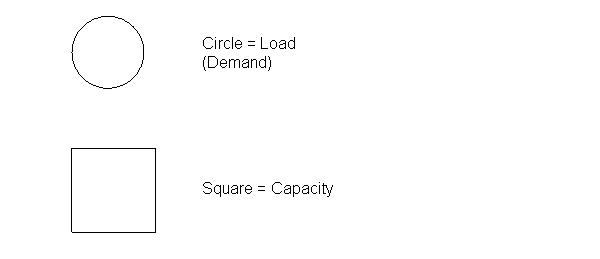
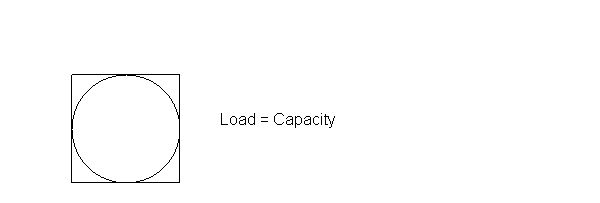
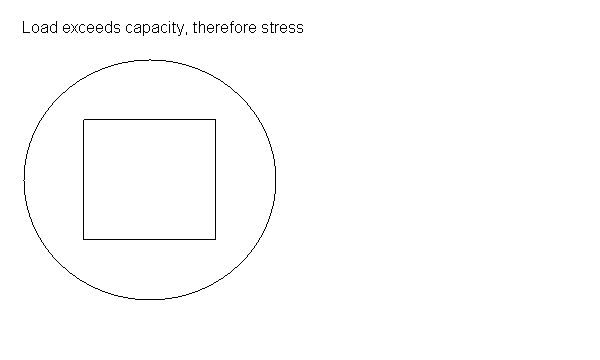
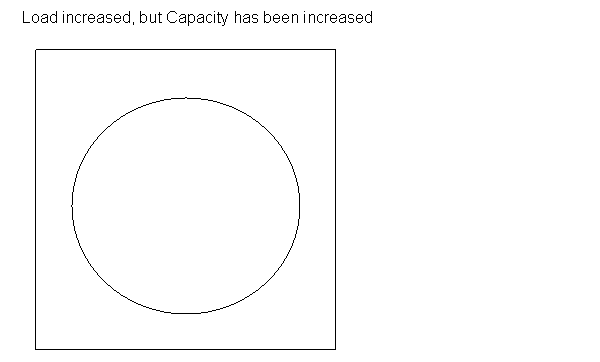
Many
people feel stressed when the size of their workload approaches their perceived
capacity for work. Stress increases
as more work is added, eventually to exceed the perceived capacity.
Ideally one hopes that the workload will decrease, but sometimes as a
result of the stress we are scarred and our capacity is reduced.
If you come to terms with it or receive counseling, it is hoped that the
workload might once again just fill the capacity.
A better solution would be to achieve more stamina so that there is
increased capacity, i.e. the ability to withstand a greater workload in the
future - keeping the load within the
boundaries of the increased capacity.
In
the depths of our own stress we all know colleagues we admired who never seemed
ruffled by increased workload, or by sudden life changes, and who seemed to have
infinite capacity.
Weight-on-a-Spring
model
Against
the background of imprecise definition of stress, the concepts of 'stressors'
and 'strains' were discriminated and offered to the students in a cause-effect
model. A 'stressor' might be work
overload, causing the 'strain' of fatigue. This is illustrated by the
Weight-on-a-Spring
model, the Weight representing the stressor and the extension the strain
(Russell 1953).
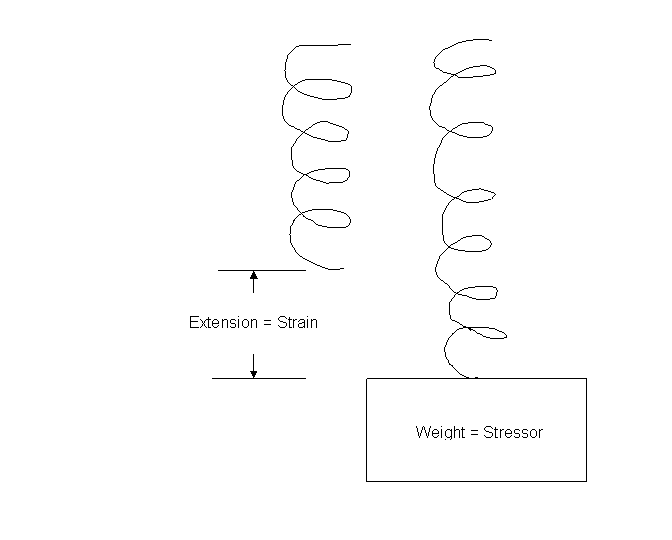
This
model was useful when first presented, but the students soon noticed that a
strain could switch to being a stressor, leading to a chaining effect. For
example, the strain of fatigue could become the stressor causing the strain of a
weakening family relationship. A
stress counselor should enter the chain by defining the stressor and strain at
point of entry. There is cost to a client, and difficulties for a counselor, who
fails to find the break-point of entry to a closed loop stressor-strain cycle.
Three-Systems
model
The
students were given local, national and global suicide and mortality figures,
with their relationships to variables such as socioeconomic
background and marital status.
This led to listings of stress-related illnesses.
The students showed wide variation in their beliefs about discrimination
and generalization of this concept, which was not surprising given the
background of an imprecise definition of ‘stress’ itself.
The students understood and accepted the Three-Systems Model of behavioral,
emotional and physical
interaction as described by Powell and Enright (1990), but they barely mentioned
it in discussion, counseling or essays. Perhaps
the students felt the model to be too naïve, obvious or inappropriate, even in
conditions where its originators saw its relevance.
Perhaps being a textual model it was easily forgotten.
However when students failed to observe behavioral, emotional and
physical changes at an early stage in a counseling situation, there were
cumulative difficulties in reducing client anxiety.
Type
A and B Personalities model
The
students realized that their problems could not only be blamed on the
environment but on their own reactions and interactions with it. The Type A and
B model of behavior traits (Friedman and Rosenan 1959; Glass 1977; Matthews
1982) was introduced. Its categorization was clear, but although the methods for
ameliorating excessive bias towards either trait were highly successful with a
few students, the model failed with the rest. A new model was proposed for
targeting a desirable but hypothetical middle-road Type ‘C’ behavior and
developed by role-play to even more satisfying Types D, E, F - - - and
subsequent behaviors, where for example reaction to a novel, unexpected event,
shock or emergency situation could be controlled to prevent disablement of
thought or action. Assuming
attitudes are difficult to change quickly by conventional methods (except by
unfortunate negative shock events), the students found that much practice was
needed to reach the ‘higher’ levels of C, D, E - - - behavior, beyond the
traditional Types A and B. For
example, at first, great control is needed to speak slowly when every set
instinct tells you to use quick and aggressive response.
Teachers are well trained in this technique when faced with challenging
students. Ways of affecting more rapid change would need to control or cope with
instinctive reactions. Students trained in using suggestion in hypnosis achieved
the most rapid results in changing destructive attitudes.
Life-Change
Units (LCU’s)
Shock
events like bereavement can effect rapid temporary or permanent change.
Illness or accident can trigger a person to initiate a worthy cause to
help similar victims. The students
completed the Holmes and Rahe (1967) Life-Change Inventory, but found that their
reactions to a life-change event were dependent on their hardiness, mental
stamina and parental or vocational training -
Life-Change
Model
This
model suggests that life changes or job changes cause the stress.
Life changes have been placed in a hierarchy.
At the top of the list is 'death of a spouse'.
'Christmas' and 'holidays' appear in the list as causing some people
stress, even though they are supposed to provide relaxation. Each life-change
item in the list is allocated a score. You
add your scores and the total indicates your stress level.
Perhaps
each profession should develop its own LCU’s. For example, teachers are
subject to their own list of internal life changes - sudden changes in
collaborative teams, the curriculum or family problems. Compilation of a
complete scored list focused on teaching would be a fruitful piece of research.
Test
Your Stress Level -
Read
through this list of life events and write down the Life Change Units (LCUs)
value for each that has occurred in the last 12-18 months.
Total
your Life Change Units (LCUs). If your score is 150 LCUs or less, your level of
stress based on life changes is low. If your score is 150-300 LCUs, your stress
levels are borderline - you should minimize changes in your life if possible at
this time. If your score is more than 300 LCUs your stress levels are high. You
should minimize other changes in your life if possible and work at instituting
some stress intervention techniques.
|
Ranking
of Life event |
LCU |
|
1.
Death of Spouse |
100 |
|
2.
Divorce |
73 |
|
3.
Marital Separation |
65 |
|
4.
Jail Term |
63 |
|
5.
Death of close family member |
63 |
|
6.
Personal injury or illness |
53 |
|
7.
Marriage |
50 |
|
8.
Fired from job |
47 |
|
9.
Marital reconciliation |
45 |
|
10.
Retirement |
45 |
|
11.
Change in health of family member |
44 |
|
12.
Pregnancy |
40 |
|
13.
Sex Difficulties |
39 |
|
14.
Gain of new family member |
39 |
|
15.
Business readjustment |
39 |
|
16.
Change in financial state |
38 |
|
17.
Death of close friend |
37 |
|
18.
Change to different line of work |
36 |
|
19.
Change in number of arguments with spouse |
35 |
|
20.
Mortgage/loan for major purchases |
33 |
|
21.
Foreclosure of mortgage or loan |
31 |
|
22.
Change in responsibilities at work |
29 |
|
23.
Son or daughter leaving home |
29 |
|
24.
Trouble with in-laws |
29 |
|
25.
Outstanding personal achievement |
28 |
|
26.
Spouse begins or stops work |
26 |
|
27.
Begin or end school |
25 |
|
28.
Change in living conditions |
24 |
|
29.
Revision of personal habits |
23 |
|
30.
Trouble with boss |
20 |
|
31.
Change in work hours or conditions |
20 |
|
32.
Change in residence |
20 |
|
33.
Change in schools |
19 |
|
34.
Change in recreation |
19 |
|
35.
Change in church activates |
18 |
|
36.
Change in social activities |
17 |
|
37.
Mortgage, or loan for lesser purchase (car etc.) |
16 |
|
38.
Change in sleeping habits |
15 |
|
39.
Change in number of family get-togethers |
15 |
|
40.
Change in eating habits |
15 |
|
41.
Vacation |
13 |
|
42.
Christmas |
12 |
|
43.
Minor violation of the law |
11 |
Stress
is the body's non-specific response to any demand placed upon it. It is
not caused only by negative or adverse influences. Stress increases the rate of
wear and tear the body experiences. Americans spend over nine billion dollars a
year to deal with stress.
Ritualistic
model
The
ritualistic model is related to the load capacity model and to the life change
model. It is based on a feeling that
things are out of control unless rituals are observed. Eventually this blocks
creativity and innovation. The rituals are not confined to working hours. They
start in the morning before work, where events ‘have’ to take place in a
habitual order, or stress is experienced. In the stress management course,
students were weaned from rituals by setting them a homework assignment to break
at first just one ritual. They said it was the most difficult assignment of the
course. Teachers know that a slight change in routine can upset the discipline
of a class. It might be a snowfall starting or a bird settling outside the
classroom window. Perhaps the education system should devote itself in the
affective domain to teaching children to react appropriately to novel
situations, essential for encouraging creativity.
Moving
animal model
A
simple ‘moving animal’ model was found to be very effective. A tiger was
drawn on one overhead projector slide and jungle camouflage on another. The two
slides were placed on top of each other on an overhead projector.
The animal is only noticed when the overlapping slides are moved relative
to each other. The analogy in stress management is that many people are happy to
preserve the status quo and only experience stress when changes are made in
their working life. This model
helped to exercise the ‘detector function’ described later in Kuhn’s model
(1974).
Microstressors
model
To
complement the life change inventory, the effects of cumulative small stressors
were examined. Research articles have started to appear showing for example some
evidence of a link between these 'microstressors' and depression (
Assertiveness-Relaxation
model
Many
of the students asked to be taught Assertiveness. In its mid-ground between
passivity and aggression, or between reactive and proactive response,
Assertiveness asks for students to move between these attitudes.
Like switching between Type A and B, it was difficult to break lifelong
habitual responses to situations. Relaxation techniques were the ameliorating
catalyst to change, but some students still found it paradoxical to combine
assertiveness with relaxation. Relaxation was therefore practised both in
preparation for being more assertive when rights were infringed and also for
defusing the aggression of other people. For most students extensive role-play
and feedback from external situations effected the desirable responses.
Learning curves model
When
students realized that stress management would often involve simultaneous
changes to themselves and to their environment a return to the first principles
of learning was needed. They had to learn how to learn new responses to
stressors. This was difficult because of their ritualizations. Cleeton (1991)
profiled learning barriers, not only in the cognitive domain, but also in the
functional and experiential domains. Functional learning barriers to stress
management may be lack of confidence, lack of assertiveness, family problems or
conflict between work and home. Experiential learning barriers may be lack of
experience in dealing with problems normally arising at work or home. The
students were shown examples of learning curves -
Curve
showing a linear rate of learning
achievement
steep
(fast learner)
 |
shallow
(slow learner)
![]() time
time
Curve
showing linear learning, but starting from some previous knowledge
achievement
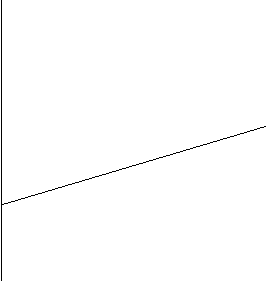 |
--------Previous knowledge
![]() time
time
More
realistically, the following curve shows how many of us learn. It is called the
‘stepped-change model’. For example, when we learn how to play a musical
instrument, we achieve an elementary level quite rapidly, and then seem to
‘stick’ at that level and think we will never rise above it. After a number
of steps, we may reach a ‘plateau’ where we either give up the practice and
learning, or realize that we have reached the limit of our persistence or
ability
-
Curve
showing stepped learning
achievement
![]()
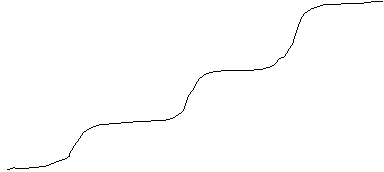 plateau
plateau
step
time
The
following curve reproduces an actual performance by an adult learner. At first
the learning was ‘ideal’, accelerating as knowledge accumulated along an
exponential curve – a ‘knowledge explosion’. Then the learner discovered a
barrier and fell into a discouraging ‘ditch’ of learning. Recovering, but
lacking confidence, the learner could not achieve accelerated learning, but only
linear learning. A second fall into a ditch leaves the learner so discouraged
that some previous learning could not remembered (a learning ‘block’), but
eventually recovery took place to reach a plateau of ability and persistence.
Learning
Curve showing actual performance of an adult learner
achievement
![]()
plateau
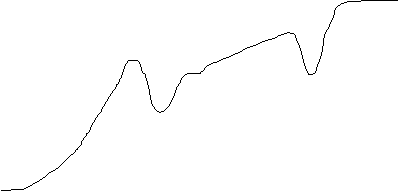
linear
learning -
ditch
ditch
accelerated (‘ideal’) learning
![]()
time
The
following curve shows ‘ideal’ learning, usually produced by material which
is challenging but not anxiety-producing. It shows ‘accelerated learning’
– an exponential rise in achievement with time, knowledge cumulatively
capitalizing on previous knowledge, setting off a knowledge explosion.
‘Ideal’
Learning Curve
achievement
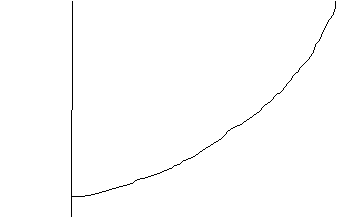
![]()
time
Relating
these curves to stress management, students need to strive for ‘ideal’
exponential learning and avoid ‘ditches’ and ‘plateau’. Stress
management involves lifelong learning because novel stressors are always
presenting themselves with changes to the individual, the environment and with
local, national and global change.
Perception
and Reality model
Learning
Barriers
The
author (Cleeton G., 1996) developed terminology to describe learning barriers.
Have you ever heard adults or children say, ‘I can’t do Math’? They are
expressing a perceived learning
barrier. In practice the barrier may be real
or illusory. Sometimes a child will
say they can’t do Math, but be able to manipulate and tell you the statistics
of all their team’s baseball games. In that case the barrier must be to some
extent illusory. When adults return to
the classroom after a gap of many years, they are often scarred with memories of
failure in school, sometimes from bad teaching, for example from teaching
abstract before concrete operations. These scars caused ditches in their
learning curves. Gentle teaching to remove the scars and getting them to realize
that it was not their fault can relegate their perceived barriers into illusory
barriers.
Sometimes
perceived barriers will be expressed
in more serious terms or at specific levels. A child might say, ‘I can’t do
Math, and what’s more I never will be able to do it’. This suggests that
there is a hierarchy of learning
barriers. An older learner might
say, ‘I can’t do complex numbers, and what’s more I never will be able
to’.
Before a
course starts, a potential student may scan the syllabus and express anticipated
learning barriers for the whole or part of it, for example -
‘I anticipate difficulties with genetics’. This can cause a damaging
mindset. Piaget and Inhelder (1971) said, ‘That which is anticipated is more
likely to occur’ - an example of ‘negative’ or pejorative visualisation.
In
stress management the tutor needs to demonstrate that many anticipated and perceived
barriers can be illusory, and also
teach how to overcome real barriers.
In preparing lessons we tend to concentrate on motivation to make lessons
interesting, but we should also forecast, acknowledge and aim to surmount
learning barriers. Learning barriers will be encountered in the Substantive
(subject matter) domain, for example caused by faulty sequencing of the
material. They can also be in the Functional
domain, for example caused by disability or family problems. They can be in the Experiential
domain, for example caused by lack of practical experience in needed skills.
There are several models of learning barriers. Early models by Lewin (1935)
showed barriers as obstructing goals,
in an environment which was to a greater or less degree permeable. As teachers
our role is to set the goal and make the teaching environment as permeable and
flexible as possible to surmount the learning barriers.
An
insidious learning barrier is the discovered
barrier. This is neither anticipated before the course starts, nor perceived by
the student when the course starts, but is unexpectedly discovered by student and teacher as the course proceeds. Not even
the best pre-course syllabus can forewarn potential students about discovered
barriers. Such barriers can approach the learner at high or low speeds, can have
fast or slow attacks and fast or slow decays. Their profiles will resemble those
generated by music synthesizers –
Learning
barrier with fast attack and slow decay
barrier
height
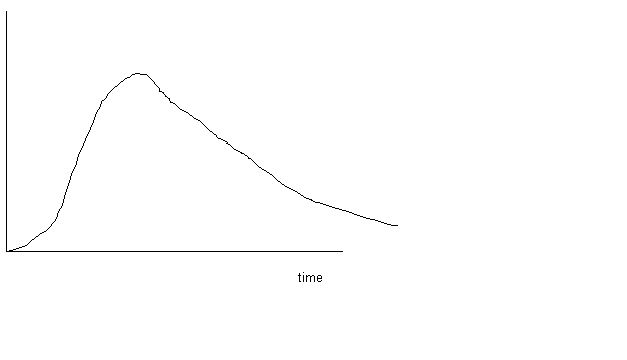
Learning
barrier with slow attack and fast decay
barrier
height
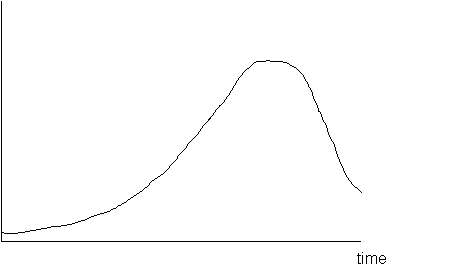 |
Learners
are not particularly realistic about their learning potential. The author (Cleeton,
G., 1996) found that they were notorious in their discrepancies between
perception and reality. Mostly they were pessimistic, sometimes optimistic.
Skilled teaching can bring them into reality without discouragement.
Weaknesses
were apparent in students' decision-making skills. They tended to act either in
a stereotyped way when faced with novel outbreaks of stress, or at the other
extreme would vacillate between trial of different solutions. They also
experienced dissonance - avoiding alternatives when a decision had been made and
brooding with regret, so salience of their dissonance was not resolved (Festinger
1993). Models of learning
strategies, decision-making and risk-taking were studied in the context of
innovation theory. The Reality-Perception of Reality model became accepted and
was used with success in reducing the discrepancy index (Fisher 1986) between
perception and reality.
Child-Within
model
Students
also noted discrepancy between perception and reality in conflicts between the
conscious and subconscious minds. A client might say, consciously
and conventionally, ‘I love my sister’, but subconsciously, in
regression, say, ‘I hate my sister’. Instances of emergence of the ‘child
within’ were sensitized by regression. Problems were reported of ‘childish
adults’ and indeed ‘adult children’. Reluctantly some of these effects
began to be recognized by the students as lying within themselves and led to
their determination to remove the ‘bugs’ from their systems before
practising stress management on other people.
Time
management model
The
stressors of learning and of meeting targets were approached through time
management and just-in-time management, keeping long-term diaries of activities,
relaxation and thinking. Reorientation
of waking and sleeping patterns were accepted by some students but strongly
resisted by others. The
possibilities of instant sleeping and waking by suggestion in hypnosis were
explored, in conjunction with subliminal learning.
Marionette
on Strings model
The
human being is a delicate instrument, partly controlled by ‘strings’ to the
different people in his/her life. When
one of these people pulls a string that attached to the human being too tightly,
the string or the human being can ‘snap’ and be either mentally, physically
or both mentally and physically destroyed. Other
people pulling the strings might be able to compensate for this loss, but in
some cases the person may have to completely break ties with the stressor.
For example, if the stressor is an employer, the person might have to
resign to save mental and physical health.
Shifting
the Goal Posts model
The
person is told to complete a task. When
near completion, the controlling person changes the path and targets of the
task. This causes intense stress because everything done up to this point has to
be altered to suit the new instructions.
Mountain
out of a Molehill model
You
have to teach simple material that should only take a few minutes to explain,
but fill one hour in time to do it. This is a stressor for teachers, professors,
or anyone lecturing. Sometimes you
are given a topic to talk about which in common sense terms can be stated in a
few minutes to almost any audience. You have to stretch this to an hour. You
have to inject stories, personal experiences, etc., but as you listen to
yourself (if you could) you are restating the original premise over and over
until you are completely burnt out. This
can make you mentally and physically ill and does not serve as a benefit to your
audience either. It is making something more important than it is.
Contagion
of stress model
Most
of us have experience of the ‘weak link in the chain’ when working as a
team, for example the person who holds up the work by not meeting deadlines.
When prolonged this behavior can be contagious.
Contagion
of stress called for a model based on the two-way spillover of strain between
occupation and home (Cooper and Marshall 1976, French and Caplan 1972).
This necessitated assembly and modeling of family relationship stressors
and occupational stressors, and the interaction between them.
Power,
Role, Task and Person model
Occupational
stress was modeled through analysis of the Power,
Role, Task and Person structures of organizations (
Their
structural strengths and weaknesses were assessed in terms of (i) their
stability, (ii) their resistance to change, development or recessional crises
and (iii) how individuals of different personality might fare in them, or be
matched to a structure by choice.
The
following descriptions of the structures are due to
The
power culture is most often found in small entrepreneurial organizations.
Its structure can be pictured as a web.
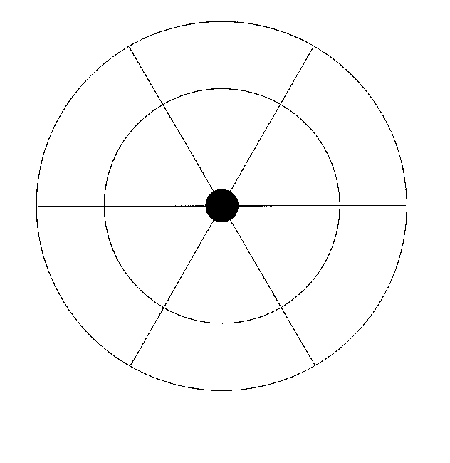
The
power culture depends on a central power source with rays of power and influence
spreading out from that central figure. The rays may be connected by functional
or specialist strings but the power rings are the centers of power and
influences.
This
organization works on precedent and by anticipating the wishes and decisions of
the central power sources. There are few rules and procedures and little
bureaucracy. Control is exercised from the center. It is a political
organization in that decisions are taken largely based on the balance of
influence rather than on logical or procedural grounds.
A
power culture can move very quickly and react rapidly to threats or
opportunities. These cultures put a lot of faith in the individual, little in
committees. They judge by results and care very little about the means used to
obtain results. Size is a problem for power cultures; when they get large or
when they seek to take on too many activities, they can collapse.
________________________
The
role culture is called a bureaucracy. The structure for a role culture
can be pictured as a Greek temple.
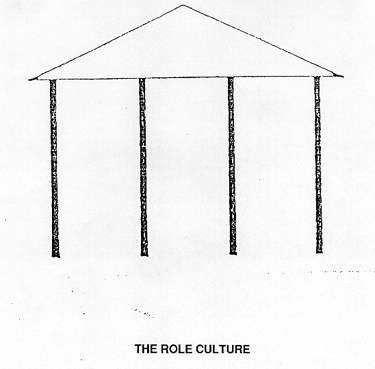
The
role culture works by logic and rationality. Its strength in its its pillars or
functional specialties, e.g. the finance department, the technical services
department, the public services department. The work of the functional
departments is contro lled by:
| Procedures for roles -- Job descriptions,
authority definitions | |
| Procedures for communications -- required sets
of copies of memos | |
| Rules for settlement of disputes -- appeal
process. |
The
functional departments are controlled at the top by a small group of senior
managers (the pediment of the temple). It is assumed that these folks are the
only co-ordinators required if the separate departments do their job as laid
down by the rules and procedures and the overall plan.
In
the role culture, the job description is often more important than the
individual who fills it. Individuals are selected for satisfactory performance
of a role and the role is usually so described that a range of individuals can
fill it. Performance above and beyond the role prescription is not required and
can even be regarded as disruptive. Position power is the major power source;
personal power is frowned upon and expert power limited to its proper place. The
efficiency of this culture depends o n the rationality of the allocation of work
and responsibility rather than on individuals.
The
role organization will succeed very well in stable environments where little
changes from year to year and predictions can be made far in advance. Where the
organization can control its environment, where its markets are stable,
predictable or controllable, the rules and procedures and the programmed
approach to work will be successful.
Role
cultures are slow to perceive the need for change and slow to change even when
the need is seen. If the market, the product/service needs, or the environment
changes, the role culture is likely to continue without change until it
collapses or until the top management is replaced.
Role
cultures offer security and predictability to the individual -- a steady rate of
ascent up the career ladder. They offer the chance to acquire specialist
expertise without risk. They tend to reward those wanted to do their job to a
standard. A role culture is frustrating for the individual who is power-oriented
or who wants control over his/her work. Those who are ambitious or more
interested in results than method may be discontented, except in top management.
The
role culture is found where economies of scale are more important than
flexibility and where technical expertise and depth of specialization are more
important than product innovation or product cost.
__________________
The
task culture is job or product oriented or focused on service delivery.
Its accompanying structure can be represented as a net.

Notice
some of the strands of the net are thicker and stronger than the others. The
power and influence in a task culture lies at the intersections. A matrix
organization is one form of the task culture.
The
task culture seeks to bring together the appropriate resources, the right people
at the right level of the organization, and then to let them get on with it.
Influence is based more on expert power than on position or personal power,
although these power sources have an effect. Influence is more widely dispersed
than in other cultures and each individual in the culture tends to think he/she
has influence.
The
task culture is a team culture where the outcome, the result, the product of the
team's work tends to be the common goal overcoming individual objectives and
most status and style differences. The task culture uses the unifying power of
the group to improve efficiency and to identify the individual with the
objective of the organization.
The
task culture is highly adaptable. Groups, project teams, or task forces are
formed for a specific purpose and can be reformed, abandoned or continued. The
net organization works quickly since each group ideally contains within it all
the decision-making powers required. Individuals have a high degree of control
over their work in this culture. Judgment is by results. There are generally
easy working relationships within the group with mutual respect based upon
capacity rather than age or status.
The
task culture is appropriate where flexibility and sensitivity to the market or
environment are important. The task culture fits where the market is
competitive, where the product life is short, where speed of reaction is
important.
The
task culture finds it hard to produce economies of scale or great depth of
expertise. Large scale systems are difficult to organize as flexible groups. The
technical expert in a task culture will find him/herself working on various
problems and in various groups and thus will be less specialized than his/her
counterpart working in a role cultures.
Control
in a task culture is difficult. Control is retained by top management through
the allocation of projects, people and resources. But little day-to-day control
can be exerted over the methods of working or the procedures without violating
the norms of the culture. Task cultures flourish when the climate is agreeable,
when the product is all-important, when the customer is always right, and when
resources are available for all who can justify using them. ( ‘for example
putting a Man on the Moon by 1970’ – Ed.)
When
resources of money and people have to be rationed, top management may wish to
control methods as well as results. When this happens, team leaders begin to
compete for resources using political influence. Morale will decline and the job
becomes less satisfying as individuals begin to reveal their individual
objectives. When this happens the task culture tends to change to a role or
power culture.
The
task culture is usually the one preferred as a personal choice to work in by
most managers especially those at junior and middle levels. It is the culture
which most of the behavioral theories of organizations point towards with their
emphasis on groups, expert power, rewards for results, merging individual and
group objectives. It is the culture most in tune with current ideologies of
change and adaptation, individual freedom and low status differentials.
________________________
The
person culture is an unusual one and won't be found in many organizations
but many individuals cling to some of its values. In this culture the individual
is the central point. If there is a structure or an organization it exists only
to serve and assist the individuals within it. If a group of individuals decide
that it is in their own interests to band together in order to do their own
thing more successfully and that an office, a space, some equipment, some
clerical support would help, then the resulting organization will have a person
culture. Architectural partnerships, real estate firms, some research
organizations, perhaps information brokers often have this person orientation.
Its structure is minimal, a cluster or galaxy of individual stars may be the
best picture.
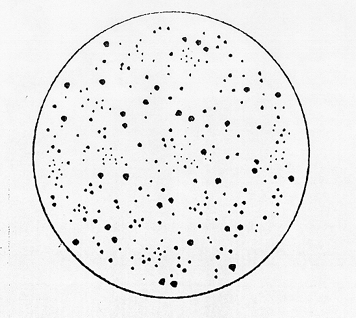
As
most organizations tend to have goals and objectives over and above the set of
collective objectives of their members, there are few organizations with person
cultures. Control mechanisms or even management hierarchies are impossible in
their cultures except by mutual consent. The organization is subordinate to the
individual and depends on the individual for its existence. The individual can
leave the organization but the organization seldom has the power to evict an
individual. Influence is shared and the power base is usually expert.
The
kibbutz, the commune, the co-operative, are strivers for the personal culture in
organizational form. Rarely does it succeed beyond the original creators. Very
quickly the organization achieves its own identify and begins to impose it on
its individuals. It becomes a task culture at best, but often a power or role
culture.
Although
there are few organizations with person cultures, many individuals with a
personal preference for this type of culture operate in other kinds of
organization. Specialists in organization often feel little allegiance to the
organization but regard it rather as a place to do their thing with some benefit
accruing to their employer. Individuals with this orientation are not easy to
manage. As specialists employment elsewhere is often easy to obtain so resource
power has less potency. They rarely acknowledge other people's expert power.
Coercive power is not usually available which leaves only personal power and
such individuals are not easily impressed by personality.
___________
Within
an large organization different types of cultures may be found as shown in the
diagram below:
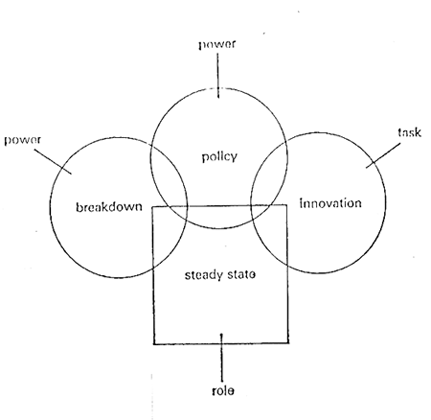
The
second diagram (due to Harrison 1972) below points out some of the organization
design policies variables that need to be considered when considering the nature
of an organization and its fit with its environment.
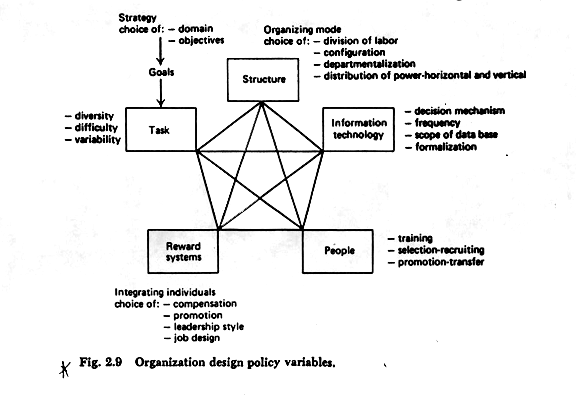
Detector,
Selector, Effector model
Students
had by now realized that that success in stress management would not only
involve changes in the environment but also changes in themselves, with feedback
between these two systems.
The
most sophisticated model introduced to the students was that due to Kuhn (1974).
It proposes the organism has Detector,
Selector and Defector functions,
is set within its environment and has feedback between these three functions
through the environment -

A closed system is one where
interactions occur only among the system components and not with the
environment. An open system is one that receives input from the
environment and/or releases output to the environment. The basic characteristics
of an open system is the dynamic interaction of its components, while the basis
of a cybernetic model is the feedback cycle. Open systems can tend toward higher
levels of organization (negative entropy), while closed systems can only
maintain or decrease in organization.
Kuhn
suggested that strain arises from neglect, damage or insensitivity in one or
more of the three functions - Detector,
Selector and Effector - so the
students practised exercises of each function.
Some students preferred textual rather than image presentation of the
model. Having applied the Kuhn
model, some students were able to inject a fine structure proposed by Kuhn,
where each of the three functions has its own Detector, Selector and Defector.
Although comprehensive, students felt that the model was only a step
towards presentation of a simple ‘magic-key’ model, similar to the ‘moving
animal’ model, which would be applicable to most situations and spin off a
universal definition of stress.
|
|
Overview of the stress models
|
Model |
Advantages |
Disadvantages |
|
Tap
and Jug |
Simple |
Inadequate,
makes false assumptions |
|
Capacity
- Demand |
Simple |
Inadequate,
too specific |
|
Weight
on a spring |
Defines
stressors and strains |
Chaining
of stressors and strains |
|
Three
systems |
Observation
of early warning signs |
Difficult to remember, too textual for Imagers |
|
Type
A and B |
Coping
strategy |
Difficult
to practise necessary changes. Inconsistent
- ignores microstressors. |
|
Life
change units |
Clear
categorization |
Insufficient
detail for specific occupations |
|
Ritualistic |
Benefits
of gaining flexibility |
Difficult
to break rituals in a short time |
|
Moving
animal |
Vivid presentation -immediately useful, also later
in complex |
Too
specific |
|
Microstressors |
Useful
relationships emerging for depression |
Tedious
to record Microstressors and their subsequent strains |
|
Assertiveness-relaxation |
Popular
need |
Paradoxical |
|
Learning
curves |
Confidence-building,
overcomes fear of innovation |
Student
preference to retain destructive status-quo |
|
Perception
and reality |
Challenges
cherished assumptions |
Too
textual for Imagers |
|
Child
Within |
Recognizes
suppressed events |
Unpopular
for those who must see causal strain-stressor connection |
|
Time
management |
Connects
time management with personality |
Needs
long-term record-keeping |
|
Marionette
on Strings |
Involves
personal relationships |
Tends
to absolve individual from change |
|
Shifting
the Goal Posts |
Useful
for meeting deadlines |
Assumes
powerlessness |
|
Mountain
out of a Molehill |
Prioritizes
tasks |
Assumes
powerlessness |
|
Contagion |
Issues
warning signs of stress accumulation |
Difficult
to disentangle connections |
|
Power,
Role, Task and Person |
Understanding
structure in which one works |
Ignores
personality clashes within structures |
|
Detector,
Selector, Effector |
Comprehensive,
open to expansion |
Complex,
suggesting need for simplification |
Discussion
Many
stress management courses have had to follow the pattern of counseling based
upon vague definitions of stress, which leads to loss of focus. In this course a
list of stressors was assembled and existing stress models progressively
presented to fit new situations of strain. Diverse
models had to be remembered and fitted to diverse problems. Students leaving the
course felt that the necessary transfer to novel outbreaks of stress had not
been achieved. Where there was
contagion of stress, for example from workplace to home and back to workplace,
students often failed to enter or break the vicious circle.
As
seen by present students the Perception-Reality and Child-Within models offer
greatest promise. They cope with variations in life goals. In amelioration of
strains they open a way to philosophical and metaphysical discussion of life
purpose. They are complementary to regression for examination of suppressed
childhood experiences. They bridge traditional and alternative healing.
In
the fundamental problem of finding the cause rather than treating the problem,
frequently the default has to be that of giving coping strategies for the strain
when inability or incompetence has failed to reveal the stressor.
Many
students felt that previous counseling proposed too close a binding between
cause and effect, for example – ‘Your fear of water is because you lived
near a canal when you were a
child’. It may be prudent to
consider the possibility that sometimes there may be no such binding - that
there is an element of chance whether an unfortunate child event causes adult
anxiety, depression or phobia. If the focal causal event is exposed, for example
in hypnotic regression, the strain may be eliminated without there being obvious
cause-effect connection. Similarly in the human variation of response to events,
there may be no relationship between the severity of a problem and the severity
of the cause (and therefore severity or duration of treatment).
Proposals
for new modeling of stress
In
the absence of explicit definition of stress, new models will constantly been
needed. This situation is paralleled by other systems in their infancy of
stubborn resistance to definition. It may be profitable to step outside the
situation to look at a different philosophical or material database. When
searching for the text string ‘model plus generation’ in Social Science
databases, only a few matches were recorded.
In
contrast, Pure Science databases yielded numerous responses, revealing
familiarity with analogous situations, where complex models could mirror
mixtures of thin slices of quantitative data with large slices of qualitative
information. For example, the ‘state space framework’ was used by Patterson
(1995) to apply a model integrating data generation process with data
measurement.
Methodologies
of kinetic modeling and mechanistic studies of complex catalytic chemical
reactions have been analyzed by Gabrielle, Denoroy and Reau (1995). They showed
the rationality of a methodology based on advancement and discrimination of
hypotheses and gave a review of techniques for hypothesis generation. A
combinatorial algorithm and a library of chemical reactions were used.
Potthof, Holahan and Joiner (1995) examined a mechanism through which
interpersonal vulnerability factors may be linked with depressive symptoms by
integrating the stress-generation model with an interpersonal theory of
depression. Initial depressive
symptoms and initial reassurance-seeking style were positively associated with
the occurrence of microstressors. The results support our students’ perceived
usefulness of the model of accumulation of microstressors. Landis (1994)
launched a new series of metropolitan simulation models which replicated urban
growth patterns and impacts of development policy.
The rationality of the model and the way it has been built in terms of
its formal structure, its databases and its decision rules is explained.
Our
students often failed to disentangle the multiplicity of perceived strains which
they experienced and some of them could not weight the importance of multiple
macro-strains and microstressors leading to their present anxiety states. This
indicates the potential for multifactorial modeling, such as used by Rosenheck
and
Since
the strains defined by student-counselors in their clients may be wrongly
attributed to stressors, the top-down approach to modeling may be the way
forward. The techniques of reverse
engineering might be adopted. Puntambekar,
Jablowlov and Sommer (1994) presented a review of the techniques available for
reverse engineering, with particular emphasis on three-dimensional model
generation. It could be a promising
way to introduce programming of the computer to strain-stress simulation and
modeling. Reverse engineering is a
methodology for constructing computer-aided design models of physical parts, in
circumstances where the drawings of those parts are not available by the normal
methods of (i) digitizing an existing prototype, (ii) creating a computer model
and (iii) using it to manufacture the component. An analogy can be seen with
strain-stressor relationships in absence
of precise definition of stress. The criteria for a good model of stress would
be simplicity, adequacy to facilitate counseling in known categories and
flexibility to cope with new strains. At
the base level, models are icons for images to hold a problem in view and
remember the connections.
Glenberg
and Langston (1992) investigated the building of mental models by using pictures
in text, suggesting that a picture might provide relatively easy maintenance of
some other representational elements corresponding to parts in the picture,
freeing up capacity for inference generation. Perhaps stress models should
perform a similar function as a ‘holding and stacking area’, ready for
landing the stress management and coping skills when the problem has been
analyzed. The proliferation of models by brainstorming may be the only path to a
definition of stress. However Kometsky and Markowitz (1978) drew attention to
the danger of superficial resemblances when evaluating the problem of goodness
of fit of a model. Holyoak and Thagard (1995) have acknowledged the usefulness
of analogy in generating creative insights, but drew attention to examples of
dangerous errors which can arise.
Mental
models have been studied by Rhees (1983), Craik (1973) and Johnson-Laird (1991),
who maintained that the mind constructs ‘small-scale models of reality that it
uses to anticipate events, to reason and to underlie explanation.
The models are constructed in working memory (the mind actively
interpreting newly presented information and integrating previously stored
information) as a result of perception, the comprehension of discourse or
imagination. Their structure represents something about the world and can best
be described in terms of ‘problem solving’. In problem solving the task of
constructing a mental model involves making assumptions about the problem and
understanding the meaning of terms in the problem in order to reach a conclusion
(solve the problem). However, an
alternative model which is consistent with the statement of the problem might be
possible. The Theory of Mental
Models (Johnson, Laird and Byrne, 1991) predicts that a problem is more
difficult to solve if more than one model has to be considered.
Additional models impose a load on limited working memory.
External
representations (colloquially the ‘rough work’ we do to make models or solve
problems) are in the world as physical symbols (e.g. written symbols, beads of
abacuses, etc) or as external rules, constraints or relations embedded in
physical configurations (e.g. spatial relations of written digits, visual and
spatial layouts of diagrams, physical constraints in abacuses, etc.).
Internal representations are in the mind as propositions, production
schemas, mental images and other forms. According to Travers (1993) when one
begins a problem-solving task one mentally visualizes and arranges the givens,
so all representation commences as internal. Cox and Brna (1995) maintained that
concerning the nature of internal representations, popularly debated within
cognitive science, advocates can be found for the position that internal imagery
is merely epiphenomenal (concomitant to it).
External
representations (Ers) are short lived or idiosyncratic. Studies in literacy show
the important functions of Ers. The
classical view on writing, originally developed by Aristotle and presently
restated by
Pemberton
and Sharples (1996) supported the view that Ers are the markings that writers
make, singly, or in collaboration, on some external medium such as a computer
screen. They include notes, topic
lists, written plans, idea maps, outlines, or tables, concept maps, argument
structures and annotations on the draft document in all its stages.
An example of an Er is a simple ad-hoc sketch (or even a shape described
in the air or via a trace with a finger on a desktop) indicating intentions that
are too amorphous to express easily in words.
Wood (1992), in his studies of pairs of collaborating authors, pointed
the authors to draw a large funnel shape to represent the overall structure of
the paper, and later both authors cited different places in this shape when
talking about the same parts of the paper. Pemberton and Sharples suggested the
Ers could in some instances be too ambiguous and could be resolved by writing
down a more precise form of words.
When
a sample of people is asked to describe their stress by placing it within a
stress model, they give different answers to what the stress model meant to them
as an individual.
Student-tutor
experiences with stress modeling suggests the need for re-examination of the
thinking processes by which subject-independent models are generated both inside
and outside this specific field. Promising directions seem to be those of
reverse engineering and computer-simulation of strain-stressor relationships,
and teaching enhanced skills in external representation. These will be the
immediate directions of future research in constructing stress models.
References
Cleeton
G.(1991). Development and
application of a new theory of learning barriers.
Ph.D. thesis, University of Keele.
Cleeton G. (1996). Perception and Reality of Learning
Barriers. Perceptual and Motor Skills,
1996, 82, 339 – 348.
Cooper
C.L. and Marshall J. (1976) Occupational sources of stress a review of
the
literature relating to coronary heart disease and mental ill health. Journal
of
Occupational Psychology, 49,
11-28
Cox,
R. and Brna P. (1995) Supporting the use of external representations in problem
solving;
The
Journal of Artificial Intelligence In Education, 6(2/3), 239-302.
Craik
F. (1973) “Levels of Analysis” view of memory.
IN P.PLINER et al. (Eds.),
Communicattion
and affect: language and thought.
Eysenck,
M. H. (1989). Personality, Stress
Arousal and Cognitive Processes in Stress transactions.
In Neufeld R W J (Ed) Advances in
the Investigation of
Psychological
Stress, 133-157.
Everly
G. S. and Rosenfeld R. (1981). The
Nature and Treatment of the Stress Response, Plenum,
Festinger
L. (1993). A Theory of Cognitive Dissonance.
French
J.P.R. and Caplan R D (1972). Organizational
Stress and Individual Strain. In
Marrow A J (Ed), ‘The Failure of Success’.
Friedman
M. and Rosenman R.H. (1959). Association
of specific overt behavior pattern with increases in blood cholesterol,
blood-clotting time, incidence of arcus senilis and clinical coronary artery
disease. Journal of the
American Medical Association 169,1286 -- 1296
Gabrielle
B, Denoroy, P. and Reau R. (1985)
Nitrogen dynamics in a colza planatation-modelling ecological impact.
OCL-Oleagineux Corps Gras Lipides, 2. 1,8-10.
Glenberg
A.M. and Langston W.E. (1992). Comprehension of illustrated text:
Pictures help to build mental models. Journal of
Memory and Language, 31, 2,129 -- 150
Holyoak
K. J. and Thagard P. (1995). Mental
leaps: Analogy in Creative Thought.
Holmes
T.H. and Rahe R. H. (1967). The
social readjustment rating scale. Journal
l of Psychosomatic Research, 11,213 --218.
Johnson-Laird
P. and Byrne R. (1991) Deduction.
Kometsky
C. and Markowitz R. 1978.
Animal models of schizophrenia. In
Lipton M.A., DiMascio A., Killiam K.F. (eds). Abio-informational theory of
emotional imagery. Psychophysiology,
16:495-2512.
Kuhn
A. (1974) The Logic of Social Systems. San
Francisco: Jossey Bass.
Landis
J. D. 1994. The California Urban
Futures Model - Anew generation of metropolitan simulation models.
Environments and planning, 21, 4,399 -- 420.
Lolas
F. (1979). The pertinence of animal
investigation for clinical stress research.
Neurobiologia., 42: 185 -- 192.
Matthews
(1982). Psychological perspectives
on the type - A behavior pattern. Psychological
Bulletin, 91,293-2333.
Patterson
(1995). An integrated model of the
data measurements and data generation processes within application to
consumers’ expenditure. Economic
Jouirnal, 105, full to wait, 54 -- 76
Pemberton
L. and Sharples R. (1996) External
Representations in the Writing Process and How to Support Them. AIEd 96 External
Representations.
Potthoff
J.G., Holahan C.J. and Joiner T.E. (1995) Reassurance
seeking, stress generation and depressive symptoms -- an integrative model.
Journal of Personality and Social Psychology 68, 4,664 -- 670.
Puntambekar
N.V., Jablokow A.G. and Sommer, H.J. (1994) Unified review of 3D model
generation for reverse engineering. Computer
integrated Manufacturing Systems, 7, 4, 259-268.
Powell
T. J. and Enright S. (1990) . Anxiety
and Stress Management. Tavistock.
Rosenheck
R. and
Rhees
R. and Anscombe G. (1983) Ludwig Wittgenstein, Remarks on the Foundations of Mathematics
Russell
R.W. (1953). Behavior under stress.
International Journal of
Psychoanalysis, 54, 1 -- 12.
Sassure
F. (1983) Courses in General Linguistics London: Duckworth.
Travers
J. (1993) Effectuve Teaching,
Effective Learning.
Wood
C. (1992). A cultural-cognitive
approach to collaborative writing. Cognitive
Science
Research
Paper CSRP 242,
Wycherley
(1997). The Living Skills Pack.
South
Yerkes
R.M. and Dodson J. D.(1908). The
relation to strength of stimulus to rapidity of how the formation.
Journal of Comparative and
Neurological Psychology. 18, 459
-- 482.
*~*~*~*~*~*~*~*~*
